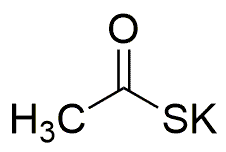Potassium thioacetate is widely utilized in research focused on:
- Analytical Chemistry: It serves as a reagent in various analytical methods, particularly in the detection of heavy metals and other transition metals, enhancing the accuracy of results.
- Organic Synthesis: This compound is crucial in the synthesis of thioester derivatives, which are important intermediates in the production of pharmaceuticals and agrochemicals.
- Biochemistry: Potassium thioacetate is used in biochemical assays to study enzyme activity and metabolic pathways, providing insights into cellular processes.
- Environmental Science: It plays a role in the remediation of contaminated sites, helping to stabilize heavy metals and reduce their bioavailability in soil and water.
- Food Industry: The compound is utilized in food preservation techniques due to its antimicrobial properties, helping to extend shelf life and ensure safety.
General Information
Properties
Safety and Regulations
Applications
Potassium thioacetate is widely utilized in research focused on:
- Analytical Chemistry: It serves as a reagent in various analytical methods, particularly in the detection of heavy metals and other transition metals, enhancing the accuracy of results.
- Organic Synthesis: This compound is crucial in the synthesis of thioester derivatives, which are important intermediates in the production of pharmaceuticals and agrochemicals.
- Biochemistry: Potassium thioacetate is used in biochemical assays to study enzyme activity and metabolic pathways, providing insights into cellular processes.
- Environmental Science: It plays a role in the remediation of contaminated sites, helping to stabilize heavy metals and reduce their bioavailability in soil and water.
- Food Industry: The compound is utilized in food preservation techniques due to its antimicrobial properties, helping to extend shelf life and ensure safety.
Documents
Safety Data Sheets (SDS)
The SDS provides comprehensive safety information on handling, storage, and disposal of the product.
Product Specification (PS)
The PS provides a comprehensive breakdown of the product’s properties, including chemical composition, physical state, purity, and storage requirements. It also details acceptable quality ranges and the product's intended applications.
Certificates of Analysis (COA)
Search for Certificates of Analysis (COA) by entering the products Lot Number. Lot and Batch Numbers can be found on a product’s label following the words ‘Lot’ or ‘Batch’.
Número de catálogo
Número de lote/lote
Certificates Of Origin (COO)
This COO confirms the country where the product was manufactured, and also details the materials and components used in it and whether it is derived from natural, synthetic, or other specific sources. This certificate may be required for customs, trade, and regulatory compliance.
Número de catálogo
Número de lote/lote
Safety Data Sheets (SDS)
The SDS provides comprehensive safety information on handling, storage, and disposal of the product.
DownloadProduct Specification (PS)
The PS provides a comprehensive breakdown of the product’s properties, including chemical composition, physical state, purity, and storage requirements. It also details acceptable quality ranges and the product's intended applications.
DownloadCertificates of Analysis (COA)
Search for Certificates of Analysis (COA) by entering the products Lot Number. Lot and Batch Numbers can be found on a product’s label following the words ‘Lot’ or ‘Batch’.
Número de catálogo
Número de lote/lote
Certificates Of Origin (COO)
This COO confirms the country where the product was manufactured, and also details the materials and components used in it and whether it is derived from natural, synthetic, or other specific sources. This certificate may be required for customs, trade, and regulatory compliance.


